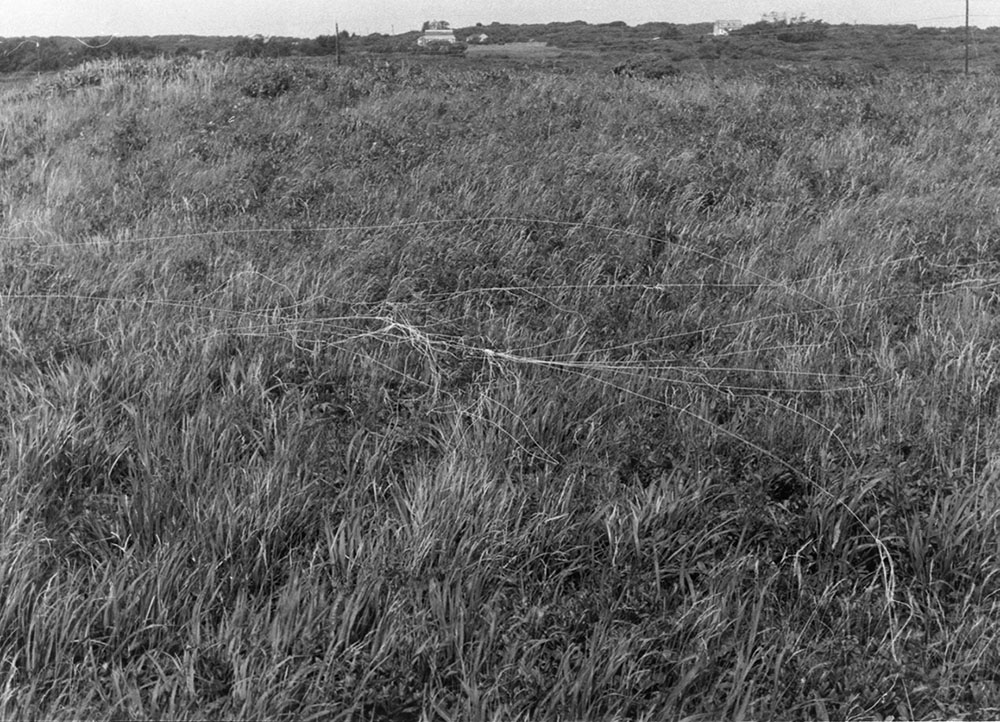
In 2010 I began making canvas thread works outdoors in the parks of New York City’s five boroughs. Many parks have wide-open spaces. I flew a kite with different weights of canvas thread, which depended on the wind speed on that day. While pulling the kite and canvas thread down, the engineering term ‘partial differential equations’ describes the threads’ falling action to the ground and the form it would take. The equations take into account the wind speed, the weight of canvas thread, the gravity, the friction, the grass, and much more. None of it is chance or random.
I make a photo document of the form.
The work no longer exists after that photo.
Edward Shalala – Artist’s Statement – August 2020
While making abstract work in graduate school at the University of Wisconsin, Madison (1973-76), I started to tear up canvas to create reassembled paintings. I often used aluminum paint over their surfaces. By my last year at the University I had torn up the canvas so thinly that its deconstructed components — canvas strips, wire, jute and string — became like my childhood art and play materials.
In 1977, embolden with my childhood art, I made an outdoor string piece by flying a kite and, letting the string go with the wind. It created a form in the high grasses. I documented the string piece with a photo.
I moved to New York City in 1977. I then traveled back to Madison, Wisconsin twice to participate in Chippewa Indian Sweat Lodges. I returned home to NYC inspired by the red-hot glowing rocks from the Lodges. I began to work on raw-canvas paintings in which I made burn marks from a steam iron, a hot plate, and a butane torch. Later I added wax and then melted oil paint with the mixture.
I continued in that vein until the early 1990s. Then I made a series of paintings with cut up small pieces of canvas, canvas threads and burlap. I collaged the pieces and threads to a stretched canvas, and then applied as many as 30 layers of oil paint to the surface.
Because of the trauma of 9/11, I wanted to innovate more urgently. I experimented. In a few instances, I painted canvas threads and then worked with a weaver to reassemble them into black, white, and red, paintings. In others, I asked the weaver to create raw canvases from unpainted canvas threads. Then I realized I didn’t need paint. I made other pieces in which I turned canvas into paper with the help of a paper making company.
Beginning in 2005 I started to make a series of paintings that were solely made with raw canvas, and raw linen-canvas. I discovered there were more than a hundred different kinds of canvas and linen canvas to choose from. There were different canvas weights, and weaves. There were different canvas colors–natural canvas colors, translucent, and opaque. Some canvases were organic, and one was bleached. There were also many linen-canvas weights, weaves and blends. I learned there were many, many international manufacturers of canvas and linen-canvas which all looked slightly different from another. All are made for painters. I uncovered a whole language.
I had gone to the source of what Cezanne had called “in reserve” which is how he described the large areas of blank canvas that he had left in his paintings.
By 2008-2010, my abstract canvas paintings became dismantled because I pulled the threads out of the warp and weft of the canvas and linen-canvases. I had paved the way for me to symbolically knock down the gallery/studio walls, like I had done thirty-two years earlier with my 1977 outdoor string work. Now all that was left of my paintings was the canvas threads.
I had created a full circle back to 1977, but with a major concept difference.
In 2010 I began making canvas thread works outdoors in the parks of New York City’s five boroughs. Many parks have wide-open spaces. I flew a kite with different weights of canvas thread, which depended on the wind speed on that day. While pulling the kite and canvas thread down, the engineering term ‘partial differential equations’ describes the threads’ falling action to the ground and the form it would take. The equations take into account the wind speed, the weight of canvas thread, the gravity, the friction, the grass, and much more. None of it is chance or random.
I make a photo document of the form.
The work no longer exists after that photo.